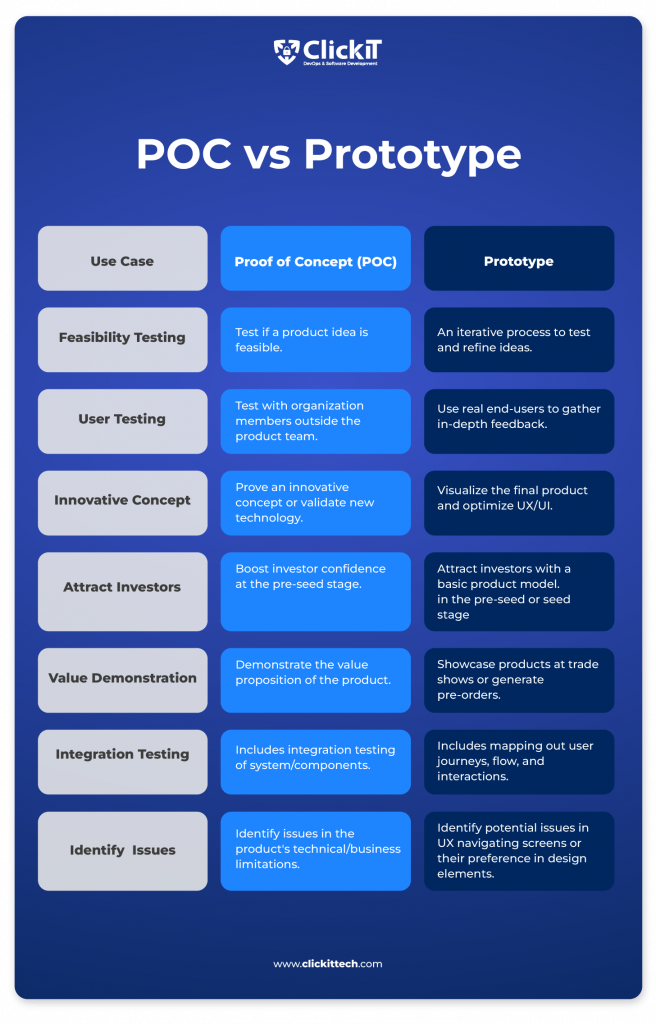You can introduce your product through a POC vs prototype in product development. Whether you’re a company or an individual, if you have an idea for a software application or product, you’re likely hoping to bring it to life soon and you need to understand the differences between Proof of concept vs prototype to know which one can benefit your product.
It’s easy to get caught up in your own bubble, thinking your idea will be the next big thing. We’re not saying it won’t be, but POCs and prototypes test if your ideas will actually work in practice. They can also help you find and refine flaws in the product’s functionality and design before investing in a full-scale production.
However, like many terms in the product development lifecycle, it’s easy to confuse proof of concept vs prototype. Knowing the difference guides the stages of your development so you plan better for each and also allocate resources effectively.
If you’re still confused, we’ve got you! Below, you’ll find everything you need to know about a Proof of Concept vs Prototype.
- What is a Proof of Concept?
- What is a Prototype?
- When do you need a POC vs Prototype?
- Summary Table for When to Use a Prototype vs POC
- Key Differences Between a POC vs Prototype
- How POC vs Prototype Complement Each Other
- POC vs MVP vs Prototype
- Conclusion
- FAQs
What is a Proof of Concept?
A Proof of Concept (POC) validates the feasibility of the core concepts, ideas, or technology behind your product. Think of it as the earliest or minimalist demonstration in your product’s journey to see if it deserves the time of day.
In essence, POC shows that the problem you’re trying to solve is solvable by the solution you’re offering. However, it’s not just for a new product; POCs are also useful for companies introducing additional features to an existing product.
Dropbox is one of the most popular case studies for a proof of concept. Drew Houston and his team had an idea for a product that would change cloud storage forever but didn’t know how to share it with their audience, especially with stiff competition. So, Drew made a 3-minute video demonstrating Dropbox’s features. They got so much market validation that even before their prototype and MVPs were released, their waiting list went from 5,000 to 75,000 overnight!
POCs are beneficial on the technical and business side.
User Feedback
Because it’s more or less a feasibility study, POC provides your technical or development team with key user feedback about the market demand, pain points, and target audience for the product.
Market Validity
It provides potential investors and decision-makers with logical proof that this concept works, fills a gap in the market, and is valuable to the target audience.
Saves Resources
If the feasibility fails, then you won’t have to invest significant time and money into developing a product. Moreover, since POCs are internal evaluations, you won’t need to fail publicly.
Understand the Product
It helps the company understand the technical team better and the product deeply. Since everyone on board is equipped with the data needed to build a product that fits the market like a glove.
Identify Risks
It can help you identify potential risks and prepare mitigation strategies ahead of time. This can speed up product releases or time-to-market.
When done right, a proof of concept lays the foundation for a successful product prototype and minimum viable product (MVP).
Types of Proof of Concept
A Proof Concept typically happens when you’re building an innovative product, introducing risky solutions/features, or using certain technologies that have never been applied to this type of product. What this means is that if there are existing products or solutions that already address the problem effectively, a POC may not be necessary because the market needs and technical feasibility are already established.
There are gray areas to consider, though. In some cases, even with similar products existing, you may still need a POC. One of those scenarios is if you’re demonstrating to shareholders or investors to prove your product is what they should invest in.
Therefore, there are different types of approaches to your Proof of Concept:
- UX Proof of Concept
- Technical POC
- Marketing
- Business Model
UX Proof of Concept
It can be confusing reading the meaning of a UX proof of concept vs prototype. They’re indeed related but have slightly different purposes.
The purpose of a UX POC is to evaluate the feasibility of your core user experience idea. For example, you have an overall concept for a product and you also have an idea of how the product would look and the user’s experience while using it. What you’re doing in the UX POC stage is validating whether users will accept your idea for the user interface design, interaction flows, and usability of the product. Think of it as a rough sketch or a low-fidelity exploration of the product’s UI/UX. In contrast, a prototype will involve refining the design and functionality of a more fleshed-out idea. We’ll talk about prototypes later on.
Technical POC
A technical proof of concept outlines the technology supporting the prospective project. A group of developers usually do this to validate the feasibility of the product from a technical standpoint.
The goal is to identify any potential technical risks and ensure that the technology can support the project’s requirements.
Marketing
POCs aren’t always about the technical and design; even marketing and sales teams are involved. After all, you have to reach an audience and convince them to use your product. That’s where a marketing POC comes in.
With a marketing POC, you’re testing different marketing strategies and campaigns to determine which is the most effective in creating awareness and converting prospects. To do this, you’ll use interviews and focus groups to gather feedback from users about the marketing strategy.
The information you get will influence the strategy you’ll eventually use when the product is fully developed and ready to enter the market.
Business Model
At the end of the day, your business needs to make money. According to this Statista study, “Lack of Financing/Investors and Running out of Cash” are the top reasons for business failure among startups globally.
If you don’t want to become one of those businesses, then it’s important to conduct a business model POC. This type of POC is used to determine whether your business model or your plan for making money is viable.
Here, you want to test the core assumptions or logic behind revenue generation. For example, is this going to be a subscription-based, freemium, pay-per-use, advertising-based, or licensing model? Doing this will also identify potential challenges with each pricing structure and customer acquisition strategy and refine your approach before going full-on into development.
What is a Prototype?
A prototype is an early version of your product to test the UX/UI design and functionality. Think of it as a simulated model or the first draft that shows the visual form of the final version and may also have some features. In essence, a prototype shows how your idea will be brought to life.
The main goal of a prototype is to provide an interactive interface that maps out the user journey and flow, their interactions with the product, the design interface, and functionalities.
A prototype is absolutely beneficial for many reasons:
Faster and More cost-effective
It provides a faster and more cost-effective way to push your products to the users and gather feedback about their experience, saving time and resources and it ’ll help identify user pain points and expectations about the product
Understand the User
A prototype helps you learn whether users had a good or bad experience navigating your product. Or perhaps they need extensive help/documentation to understand the UI.
Attract Investors
Another fantastic reason for a prototype is you could attract early adopters and investors more easily than a POC. That’s because you now have something more than just a concept—a tangible representation of a working product.
Types of Prototypes
Prototypes can come in all shapes and sizes. That is, depending on your product, market, budget, or users, there are different types of prototypes to try out. Design tools like Figma, Adobe Illustrator, Framer, InDesign, and Webflow can also be used for different types of prototypes.
Let’s look at some of the core ones to consider:
- Visual
- Clickable
- Digital
- Functional
Visual Prototype
A visual prototype is a basic mockup of the product’s user interface (UI). You could call it a no-code prototype. For example, this could even be a quick sketch using a pen and paper that shows what an app looks like and how you can use it. When using prototyping tools, a visual prototype could be a static wireframe. If you’re bootstrapping or don’t have a lot of cash in the bank, it’s probably the least expensive way to prototype.
Clickable Prototype
Now, clickable prototypes take it a notch further from just visual. With a clickable prototype, users can actually interact with the product, albeit on a basic level.
They can click through different screens and interact with elements like buttons and menus. They pretty much navigate the user journey while you gather feedback about their experience. Unlike visual prototypes, a clickable prototype can either be no-code or low-code.
Digital Prototype
A digital prototype is a virtual model of your product. Unlike a sketch on a piece of paper or just a UI you swipe through, digital prototypes can range from low-fidelity wireframes to high-fidelity mockups with features that mimic the final product.
This looks similar to the final product, and users can perform more actions besides clicking through interfaces, such as filling out forms (although the forms might not submit any data). It may also have some media integration capabilities and responsive design that adapts to different screen sizes and devices.
Functional Prototype
Now, you’ve gotten to the final stage of prototyping! A functional prototype is the closest representation of the final product.
Besides just design, a functional prototype provides a real simulation of the product’s functionality and features. That is, it allows you to test whether the product performs as expected or has any issues associated with design or functionality. Then, you can gather feedback to improve the actual product.
A functional prototype is not considered an MVP because it’s still not released into the market as a product, but only for testing purposes.

When do you need a POC vs Prototype?
Let’s quickly run through real-world use cases of when you need a prototype vs POC.
General Use Cases for a POC
- When you want to test if a product idea is feasible.
- If the only people available to test it are members of the organization outside the product team. Note that although involving real users in a POC can be beneficial, it’s not always compulsory.
- When you want to prove that an innovative concept is possible or validate the use of a new technology in a specific market.
- To boost investor confidence at the pre-seed stage.
- When you want to demonstrate the value proposition of your product.
- If the activity also involves integration testing of different systems or components, it happens in the POC stage.
General Use Cases for Prototype
Here are scenarios where a prototype is the best option:
- You’re looking for an iterative process in product development that tests and refines ideas.
- You want to visualize the final product.
- When you want to gather in-depth feedback from a small group of users on design elements and core functionalities.
- If you plan to showcase your product at a trade show, a functional prototype is a better fit and may even generate pre-orders.
- You want to optimize the UX and UI to meet user expectations before making the final decision on the product’s design.
- When you want to attract investors in the seed stage by showing a basic model of your product’s key features.
- If you plan to identify potential issues regarding the technical or business aspects of your product, a prototype is a great fit.
Summary Table for When to Use a Prototype vs POC

Key Differences Between a POC vs Prototype
The simple way to know the difference between a proof of concept vs prototype is that while a POC tests if your idea can be done, a prototype shows how it will be done and used.
Away from the purpose, let’s break down other key differences between a prototype vs POC.
Reducing Technical Challenges and User Dissatisfaction
A proof of concept minimizes the risk of technical challenges during the development stage, while a prototype reduces the risk of having unhappy users.
Development Stage
POCs are usually done in the early stages of product development when you want to see whether the idea deserves to be continued or scrapped. However, keep in mind that a POC can also be used to test the feasibility of a new feature being added to an existing product. In that case, it can be done when a prototype is ready, or the actual product has been built.
Prototypes are generally launched later in the development stage when the proof of concept has been validated. Like POCs, there’s also some wiggle room here. Although you should absolutely validate core business and technical concepts, not everything has to be figured out in the beginning to build a prototype. You can have an iterative process where you use feedback from the internal team and users to mold your idea into the final result.
Initial Resource Investment
The initial investment in terms of the timeline, effort, and money needed for a POC is usually lower than a prototype. That’s because what you’re doing is testing if this is possible rather than trying to create a model of the product.
Keep in mind that this could depend on what you’re building. In some cases, a proof of concept could be expensive. However, it’s often handled by a small team at low or zero cost. Sometimes, it could be just the founder trying to convince a business partner or an early investor. This means the investment required is lower.A prototype is generally more expensive. This is because it requires design and/or development work, depending on the type of prototype.
The Risk Involved
Another difference between a POC vs prototype is the risk involved. A POC is usually low-risk because you’re trying to avoid the bigger risk of committing resources to something that could fail. Yes, the risk of failure may be high, but you will avoid the significant sums of development in case the concept doesn’t work.
On the other hand, a prototype also helps you reduce the risks associated with developing a product that will fail. However, when you compare a prototype vs POC, the former is usually riskier because you’re taking things a notch further. More resources and real users are involved. The risk could also be higher if you didn’t have a POC or lower if you’re only testing a feature or new element in a product.
Ultimately, you’re avoiding a bigger risk with either a proof of concept vs prototype.
Features and Functionalities
Your POC only needs the core value or a standalone functionality of the product. That is, the main problem it solves or the purpose of the feature you’re introducing. In the case of a new product, the POC doesn’t contain other features.
However, prototypes can have many or all of the features that the final product will have. This could either be as a low-fidelity abstract wireframe or a high-fidelity functional prototype with all the features.
How POC vs Prototype Complement Each Other
If you ask enough people in the product development world, you’ll find quite a handful who believe POC and prototypes are the same thing. They may feel there are no differences between prototype vs POC because they have similar goals. This sentiment could be true in some cases. A POC and prototype complement each other because they both help you create a well-rounded product that meets the users’ needs and minimizes the investment risks that come with product development.
Additionally, a prototype can reinforce the findings of a POC. It can be the tangible model that convinces potential investors about a product’s suitability to the target audience. This means that despite their many differences, POC and prototypes can sometimes complement each other.
POC vs MVP vs Prototype
Besides proof of concept vs prototype, another related (and important) term in product development is the minimum viable product (MVP). An MVP is a simplified version of your product that has the core functionalities and enough features necessary to solve a specific problem for early adopters.
The most important thing to note about an MVP is that it is a real product that can sold or shipped to and used by end users. With an MVP, your product is now in the market, unlike POCs and prototypes, where only the internal team or a small group of users test it.
Releasing an MVP happens after the product’s proof of concept and prototype. The belief is that you’ve compiled all the feedback from the two initial activities and implemented them into the MVP.
It’s important to note the minimum in the MVP. This means it’s still the most basic level of your product, with more improvements to be made. As a result, there’s still room for iteration, meaning feedback is also an important part of your MVP.
Many popular apps today have used an MVP to enter the market and then made significant improvements. For example, Instagram was initially called Burbn (a location-based app), and AirBnB used to be AirBed&Breakfast. After user feedback and iterations, they have improved their product over the years.

Conclusion
As we round up the differences between a POC vs prototype, note that these are key stages when developing your product. A proof of concept is a way of demonstrating that a particular software, product, feature, or technological application can work.
On the other hand, a prototype is an early model that shows how it will look and work. These two are important in gathering feedback from users to inform your MVP or possibly discontinuing the project if there is no market fit.
To avoid diving headfirst into a project, between Proof of concept vs prototype we recommend having a POC and prototype. Not only do they reduce the risks that come with development, but they help you understand the target audience better, allowing you to build a product that satisfies them.
FAQs
Is a POC the same as a prototype?
No, a POC is not the same as a prototype. A POC validates that the concept of a product is possible or feasible. On the other hand, a prototype is a model that shows how the product will look when it’s developed.
Which comes first, POC vs prototype?
In most cases, the proof of concept comes first because it proves that the product or app is possible. Therefore, a successful POC acts as a foundation for the product journey to continue, leading to a prototype.
What is the difference between proof of concept vs prototype vs MVP?
A proof of concept validates the feasibility of the idea, a prototype visualizes the product’s design and user experience, while the MVP is the simple version of the final product with the core functionality and can be shipped into the market.
What are the best prototyping tools?
Depending on the type of prototype and the design team’s experience level, tools like Figma, Sketch, Proto.io, InVision, Origami Studio, Webflow, Framer, Azure RP, and Flinto are great for prototyping.
Can a Prototype be a POC?
Yes, a prototype can also be used as a proof of concept (POC), particularly for less complex ideas or when there’s a time constraint. This combined approach allows you to validate the concept’s feasibility while simultaneously getting a feel for the user experience.
However, the effectiveness of this approach depends on the technical complexity and the project priorities. For complex ideas, a simple visual or clickable prototype may not have enough functionality to validate the technical aspects truly. Also, if design and user experience are the priority, a separate prototype may be the best option.









